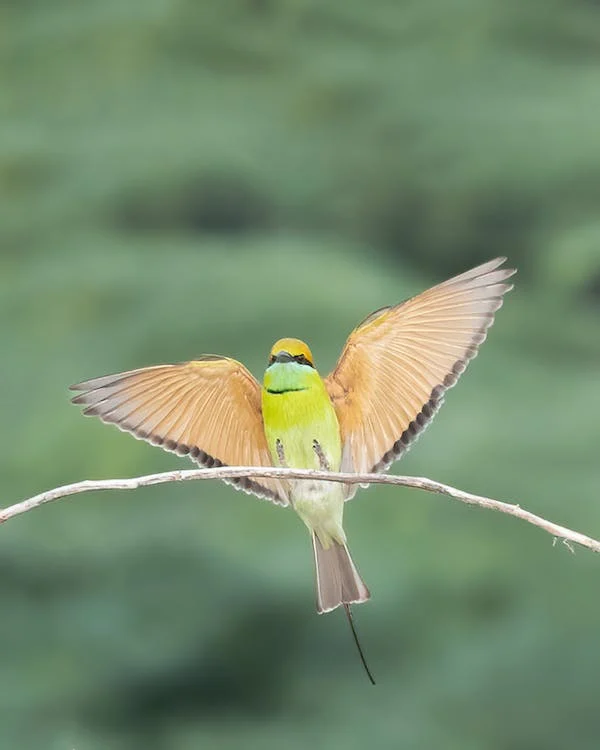The Little Bee-eater, also known as Merops pusillus, is considered a near passerine or high land bird categorized under the bee-eater family, Meropidae. They are endemic to the sub-Saharan African region, wherein they are most likely to get confused with the Little Green Bee-eater or Merops orientalis. The bee-eater family contains twenty-seven bird species with slender bodies, elongated central tail, and colorful plumage. The Little Bee-eater’s closest relatives include the Red-bearded Bee-eater, Blue-cheeked Bee-Eater, Swallow-tailed Bee-eater, and Olive Bee-eater.
This bird species was first described by German zoologist Philipp Ludwig Statius Muller in 1776. On the other hand, the bee-eater family was first regarded as a scientific classification by the French polymath Constantine Samuel Rafinesque-Schmaltz in 1815. The bee-eaters’ close relationships with other bird families such as hoopoes, kingfishers, and rollers are recognized.
Since the Little Bee-eaters inhabit an extensive range, and their general population appears to be on a stable rise, the International Unions for the Conservation of Nature (IUCN) Red List categorized this bird species as Least Concern.
Its eight levels of scientific classification are as follows:
Domain: Eukaryota
Kingdom: Animalia
Phylum: Chordata
Class: Aves
Order: Coraciiformes
Family: Meropidae
Genus: Merops
Species: M. pusillus
The physical characteristics of a Little Bee-eater
An adult Little Bee-eater measures about 15 to 17 cm and weights from 11 to 18 g, making it the smallest African Bee-eater. It is a small, mostly green-colored Bee-eater. Like other Bee-eater species, its bill is long, slender, and down-curved. It possesses a black bill, while its legs and feet are dark pinkish. Its upperparts are bright green, while its underparts and outer flight feathers are orange. It has a black collar that separates its orange breast from the yellow throat.
The center feathers of its tail are green, while the outer feathers are orange. The tip of its tail is rich brown or black. The Little Bee-eater possesses a broad, dark line that extends from the eyes to the back and a turquoise patch present above the eyes. Black patches can be seen across its upper chest. Both male and female Little Bee-eaters share the same physical characteristics.
The distribution and habitat of Little Bee-eaters
Little Bee-eaters thrive in their range. They are abundant and tame birds, estimated to be between 60 and 80 million of them. They are commonly found all over southern Africa, particularly in Namibia, Botswana, Zimbabwe, Swaziland, Lesotho, and South Africa. They frequent an extensive range of habitats such as open savannahs with bushes, preferably near a water source. They are also sighted at golf courses where they nest in holes that were excavated. They can occur in both semi-arid and high-rainfall regions. Little Bee-eaters require open space for foraging, bushes or reeds for perching, and low sandbanks for nesting.
The behavior of a Little Bee-eater
Little Bee-eaters are gregarious birds, usually seen alone, with a pair, or in small groups. They roost in large numbers at night, with up to 15 birds huddled in a row. They are conspicuous in nature, with its striking coloration and habits of foraging and perching in open regions. Migration is only limited to seasonal movements and is highly dependent on rainfall patterns.
They are diurnal species and highly social birds, spending around 10% of the day on comfort activities, including basking in the sun, dust bathing, and water bathing. Basking in the sun helps keep them warm in the morning and reduces the need to utilize their energy. It also has a social aspect to it, as Little Bee-eaters adopt the same posture. It also helps get rid of parasites in their feathers. Due to their hole-nesting lifestyle, they are highly susceptible to parasites such as flies and mites.
Little Bee-eaters nest from September to November. Their nests are usually small burrows that are usually 50 to 130 cm long, excavated in Antbear holes or low banks. Unlike other Bee-eaters, they are solitary nesters. They lay 4 to 6 white eggs, which will be incubated by both male and female Little Bee-eaters for 18-20 days.
The diet of a Little Bee-eater
As the name suggests, their dominant prey items are bees and wasps. They also feed on hornets. They catch prey while in flight, and then they proceed to the perch to beat the prey to death before eating it.
BOTSWANA BIRDS | SOUTH AFRICA BIRDS
NAMIBIA BIRDS | ZAMBIA BIRDS | ZIMBABWE BIRDS
